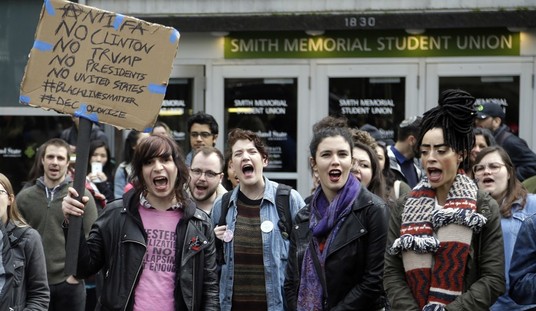Last week City Journal published a piece by Heather Mac Donald about the history of the implicit association test (IAT) and how it came to be cited by academics and many on the left as proof that everyone has implicit or unconscious racial bias.
Mac Donald’s piece is lengthy and difficult to summarize but it begins with the creation of the IAT in 1998 by, “social psychologists Anthony Greenwald and Mahzarin Banaji, with funding from the National Science Foundation and National Institute of Mental Health.” The actual test is pretty simple. Faces of white and black children are shown one at a time interspersed with “good” and “bad” words (“pleasant,” “grief,” etc.). The subject is asked to sort the faces into white and black and the words into good and bad as quickly as they can using only two keys. As the test progresses, the subject is asked to switch which key on the keyboard represents black children and which white children. And here’s how the test supposedly measures bias:
If a subject takes longer sorting black faces using the computer key associated with a “good” word than he does sorting white faces using the computer key associated with a “good” word, the IAT deems the subject a bearer of implicit bias. The IAT ranks the subject’s degree of implicit bias based on the differences in milliseconds with which he accomplishes the different sorting tasks; at the end of the test, he finds out whether he has a strong, moderate, or weak “preference” for blacks or for whites.
You can take it yourself here if you’re confused or just curious. As Mac Donald points out, this was considered a breakthrough when it was introduced and was being referenced by national leaders including President Obama and candidate Hillary Clinton:
The implicit-bias conceit spread like wildfire. President Barack Obama denounced “unconscious” biases against minorities and females in science in 2016. NBC anchor Lester Holt asked Hillary Clinton during a September 2016 presidential debate whether “police are implicitly biased against black people.” Clinton answered: “Lester, I think implicit bias is a problem for everyone, not just police.” Then–FBI director James Comey claimed in a 2015 speech that “much research” points to the “widespread existence of unconscious bias.” “Many people in our white-majority culture,” Comey said, “react differently to a white face than a black face.” The Obama Justice Department packed off all federal law-enforcement agents to implicit-bias training. Clinton promised to help fund it for local police departments, many of which had already begun the training following the 2014 fatal police shooting of Michael Brown in Ferguson, Missouri.
There was a push led by UCLA law professor Jerry Kang to incorporate the IAT into the law. It’s not hard to imagine how this could be used in an employment discrimination case or in a lawsuit against a police officer. But even as all of this cultural and legal machinery was gearing up, it turns out there is really little or no evidence that the IAT actually proves anything at all.
Any social-psychological instrument must pass two tests to be considered accurate: reliability and validity. A psychological instrument is reliable if the same test subject, taking the test at different times, achieves roughly the same score each time. But IAT bias scores have a lower rate of consistency than is deemed acceptable for use in the real world—a subject could be rated with a high degree of implicit bias on one taking of the IAT and a low or moderate degree the next time around. A recent estimate puts the reliability of the race IAT at half of what is considered usable. No evidence exists, in other words, that the IAT reliably measures anything stable in the test-taker.
But the fiercest disputes concern the IAT’s validity. A psychological instrument is deemed “valid” if it actually measures what it claims to be measuring—in this case, implicit bias and, by extension, discriminatory behavior. If the IAT were valid, a high implicit-bias score would predict discriminatory behavior, as Greenwald and Banaji asserted from the start. It turns out, however, that IAT scores have almost no connection to what ludicrously counts as “discriminatory behavior” in IAT research—trivial nuances of body language during a mock interview in a college psychology laboratory, say, or a hypothetical choice to donate to children in Colombian, rather than South African, slums…
A 2009 meta-analysis of 122 IAT studies by Greenwald, Banaji, and two management professors found that IAT scores accounted for only 5.5 percent of the variation in laboratory-induced “discrimination.” Even that low score was arrived at by questionable methods, as Jesse Singal discussed in a masterful review of the IAT literature in New York…If test subjects scored high on implicit bias via the IAT but demonstrated better behavior toward out-group members (such as blacks) than toward in-group members, that was a validation of the IAT on the theory that the subjects were overcompensating for their implicit bias. But studies that found a correlation between a high implicit-bias score and discriminatory behavior toward out-group members also validated the IAT. In other words: heads, I win; tails, I win.
To their credit, the authors of the test have admitted that the current evidence does not support using the IAT as evidence of how someone will behave. From Jesse Singal’s piece on the IAT published in January:
Both critics and proponents of the IAT now agree that the statistical evidence is simply too lacking for the test to be used to predict individual behavior. That’s not to say the two teams don’t still disagree on many issues — they do, and as we’ll see there’s some genuine bad blood — but on this point, the architects have effectively conceded. They did so in 2015: The psychometric issues with race and ethnicity IATs, Greenwald, Banaji, and Nosek wrote in one of their responses to the Oswald team’s work, “render them problematic to use to classify persons as likely to engage in discrimination.” In that same paper, they noted that “attempts to diagnostically use such measures for individuals risk undesirably high rates of erroneous classifications.” In other words: You can’t use the IAT to tell individuals how likely they are to commit acts of implicit bias.
But obviously, word hasn’t gotten to everyone who bought into their work, including the former president and Hillary Clinton. And that’s where Heather Mac Donald argues the real scandal of the IAT is that so many people seem eager to suggest questionable science of hidden bias is a significant factor in minority outcomes in the real world, even as they downplay the tangible benefits these same minority groups get in terms of corporate hiring or college admissions:
Every selective college today admits black and Hispanic students with much weaker academic qualifications than white and Asian students, as any high school senior knows. At the University of Michigan, for example, an Asian with the same GPA and SAT scores as the median black admit had zero chance in 2005 of admission; a white with those same scores had a 1 percent chance of admission. At Arizona State University, a white with the same academic credentials as the average black admit had a 2 percent chance of admission in 2006; that average black had a 96 percent chance of admission. The preferences continue into graduate and professional schools. UCLA and UC Berkeley law schools admit blacks at a 400 percent higher rate than can be explained on race-neutral grounds, though California law in theory bans them from using racial preferences.
The whole piece is worth reading and goes into the impact of the IAT on policing. She argues the whole push for the IAT has been a case study in “agenda-driven social science,” one that paints a biased picture of America.








Join the conversation as a VIP Member